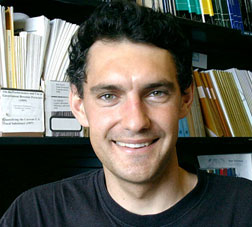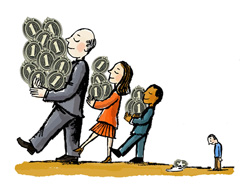The United States of Inequality
The American Economic Association's John Bates Clark medal is to the Nobel what the Golden Globes are to the Oscars. Whoever wins the Clark medal (given to an economist who makes a significant contribution before the age of 40) automatically becomes a future favorite to win a Nobel Prize in economics. Last year the Clark medal went to Emmanuel Saez, a Berkeley economist. He's French, he looks like a movie star, and he's the single most influential theoretician of the Great Divergence, which began when Saez was un très petit écolier. What Saez (in collaboration with another Frenchman, Thomas Piketty) brings to the discussion is a deeper and more complex understanding of high-income subcultures.
Before the publication of Saez and Piketty's 2003 ground-breaking paper, "Income Inequality in the United States, 1913-1998," analysis of U.S. income distribution typically derived from census records. Census data is useful if you want to track income trends for households as divided into quintiles (five groups, richest to poorest) or deciles (10). But census data is not particularly useful if you want to break down the population into much smaller groups, especially at the top end of the income scale. The rich are different—from you and me, as F. Scott Fitzgerald famously wrote, but also (and more to the point) from one another. There's the Sort of Rich. That's everybody in the top 10 percent, who today earn about $100,000 or more. There's the Rich. That's everybody in the top 1 percent, who today earn about $368,000 or more. And there's the Stinking Rich. That's everybody in the top 0.1 percent, who today earn about $1 million or more. (The blunt terminology is mine, not Saez and Piketty's.)
Saez and Piketty replaced income data from the census with income data from the Internal Revenue Service. They then broke that down more precisely than anyone had before. This yielded three discoveries.
- The American aristocracy is less different from you and me than it was in Fitzgerald's day. "Before World War II," they wrote, "the richest Americans were overwhelmingly rentiers deriving most of their income from wealth holdings (mainly in the form of dividends)." But today, they found, the top of the heap are overwhelmingly job-holders deriving most of their income from their wages. Did it become posh to have a job ? Not exactly. Having a job—the right job, anyway—became the way to get posh. That's encouraging in one sense: To roll in the dough you now have to work for a living. But it's discouraging in another sense: You can't blame enormous income disparities on non-working coupon-clippers who exist outside the wage structure (and reality as most of us understand it). The wage structure itself is grossly misshapen.
- The share of national income going to the top 1 percent (the Rich) more than doubled during the Great Divergence and now stands at about 21 percent. The chart showing this found its way into President Obama's first budget (see Figure 9), prompting Wall Street Journal columnist Daniel Henninger to call it "the most politically potent squiggle along an axis since Arthur Laffer drew his famous curve on a napkin in the mid-1970s." But where Laffer's squiggle was an argument to lower taxes, Piketty and Saez's (the conservative Henninger noted with some dismay) was to raise them on the Rich.
- The share of national income going to the top 0.1 percent (the Stinking Rich) increased nearly fourfoldduring the Great Divergence. "The [inequality] phenomenon is more extreme the further you go up in the distribution," Saez told me, and it's "very strong once you pass that threshold of the top 1 percent." Canada's and the United Kingdom's Stinking Rich followed a similar (though less pronounced) trend, but Japan and France did not; in the latter two countries, the Stinking Rich received about the same proportion of national income (about 2 percent) as the Stinking Rich did in all five countries prior to the Great Divergence. In a 2009 paper, Saez and Piketty surveyed several other industrialized nations (Table 5); in none of them did the Stinking Rich come anywhere near the 7.7 percent share of national income found in the United States.
For all three groups—Sort of Rich, Rich, and Stinking Rich—the truly dizzying gains have occurred since the early 1990s (see figures 1-3), the trend interrupted only by the dot-com bust of the late 1990s and the sub-prime bust of the late aughts. The part of the Great Divergence attributable to high-income growth—economists call it the upper tail—is exempt from most of the analysis presented thus far in this series. Relatively few of these high-earners are immigrants, relatively few make their fortunes through trade with China or Mexico, and while most of them are well-educated, they enjoy much higher incomes than most people at educational levels as high or higher. Princeton's Bartels told me his theory that partisan difference accounts for the Great Divergence can't really be applied to the upper tail because Democrats have been no more eager than Republicans to redistribute money away from the Stinking Rich (again: my term, not his). The new financial regulation law (which hadn't yet passed when we spoke) may change that calculus, but probably not by much.
A different logic applies to Jacob Hacker and Paul Pierson's theory that inequality was created largely by a growth in corporate lobbying that influenced both Republicans and Democrats. Their construct is a conscious effort to incorporate Saez and Piketty's research into a government-based model. In Hacker and Pierson's view, if you can't explain the rise of the Stinking Rich then you can't explain the Great Divergence—or at least what I'll call the Great Divergence Part II, which began in the 1990s and continued through the aughts as the more humdrum quintile-based divergence essentially halted (the bottom 20 percent actually crept up a little). Egalitarians could have declared victory if incomes for the Stinking Rich hadn't continued spurting upward like Old Faithful.
Who are the Stinking Rich? Their average annual income is about $7 million. Most of them likely work in finance, a sector of the U.S. economy that saw its share of corporate profits rise from less than 10 percent in 1979 to more than 40 percent in the aughts. The rest of the Stinking Rich are in good measure likely divided between the corporate and entertainment worlds. Among the latter two, the Rich and especially the Stinking Rich are often beneficiaries of the Winner Take All phenomenon (Kaus calls it the "Hollywood Effect"), in which those deemed best in their field are, thanks to improved technology, able to disseminate praise for their work across a broader geographic area and sell their services to many more people than they ever could in the past. Where once an accomplished chef presided over a single successful restaurant, today he can aspire to become a celebrity chef on the Food Network, which in turn can help him sell a cookbook and open additional restaurants around the country.
This logic doesn't apply to Wall Street, whose incentive structure, as documented in Michael Lewis' books Liar's Poker and The Big Short, simply went berserk starting in the 1980s with the development of ever-more-complex financial instruments increasingly divorced from traditional notions of value. An explanation of how finance came to take over the U.S. economy would require its own Slate series. But Saez, Hacker, and Pierson argue plausibly that the industry's deregulation (and the protection it received from a few well-placed Democrats like Sen. Chuck Schumer of New York) played a large role.
Nor does Winner Take All logic apply to executive pay; corporate executives don't serve a constituency any bigger than before. In 2005 Carola Frydman and Raven Saks, two young economists at Harvard (later MIT) and the Federal Reserve, respectively, surveyed compensation records on file at the Securities and Exchange Commission dating back to 1936, two years after the SEC was created. They found that pay for top executives declined sharply during World War II, increased modestly from the mid-1940s to the mid-1970s, and took off like a rocket during the 1980s and 1990s. Frydman and Saks were especially struck by the "considerable stability" during the 1950s and 1960s, a time when firms were growing rapidly and the economy was booming. Frydman and Saks noted that changing tax policy had some influence on executive compensation, but otherwise they couldn't really account for the change.
How you compare:
$52,059
Saez suggested to me that it may be because corporations today are less likely than they once were to promote from within. Instead, they have created their own Hollywood-style star system of corporate chiefs who move restlessly from one company to the next, thereby bidding up their cost. Is this rational? That's "a very hard question," Saez told me. Scholarly estimates of CEOs' impact on profits have run as low as 4.5 percent, but Saez thinks they're probably more influential than that. "CEOs make decisions that have huge consequences," he said. "They must have a huge impact."
View a visual guide to inequality. Subscribe to this series. Navigate the series from a single page. Become a fan of Slate on Facebook. Follow us on Twitter.


